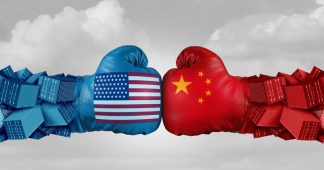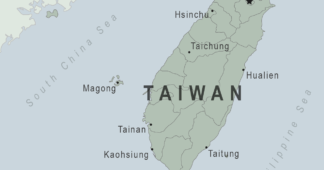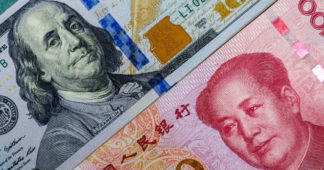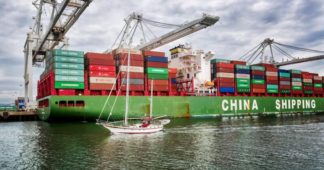Semiconductors are as important for global capitalism today as access to energy resources. Only a handful of countries can produce the most advanced microchips, and control over their supply is becoming a key battleground in the US-China trade war.
By Ben Wray
Jun 2, 2023
Is it more critical for capital and its various nation-states to guarantee a sufficient supply of energy resources or of semiconductors? In his new book Chip War, Chris Miller makes a compelling case for the latter:
“Unlike oil, which can be bought from many countries, our production of computing power depends fundamentally on a series of choke points: tools, chemicals, and software that are often produced by a handful of companies — and sometimes only by one. No other facet of the economy is so dependent on so few firms.”
Chips, then, are both essential and difficult to produce. That combination makes them central to the strategic thinking of all nation-states, and most of all to that of the United States. Washington can only sustain its imperial power through dominating the global production of semiconductors and the complex supply chain upon which that production depends.
Chip War is a history of the semiconductor industry from its origins to the present day. It is a book about technology that contributes to our understanding of the dynamics of imperialism and global political economy, even if Miller himself would not think about it in those terms.
The Rise of Chips
The rise of the semiconductor has been all about miniaturization. By getting ever-more transistors onto the same-sized piece of silicon, computer processing power continually expands.
Among the first companies to manufacture commercial chips was Fairchild Semiconductor, widely considered to be one of the founders of Silicon Valley. The first chip that Fairchild sold in 1960 had four transistors. Today, the transistor count in a chip in Apple’s iPhone 14 is fifteen billion.
The phenomenon of continual productivity gains in semiconductors is referred to as Moore’s law, after Gordon Moore, one of Fairchild’s founders. Moore wrote an essay in 1965 predicting that the number of components that could fit on a chip would double every year for the next ten years (he revised this in 1975 to a doubling every two years). Although the end of Moore’s law has long been predicted, it still largely holds true.
The US state was key to the chip industry’s liftoff. In the first half-decade of chip commercialization, around 95 percent of Fairchild’s chips were bought by NASA or the US military. While the civilian market would soon dwarf the public sector as a buyer of chips, US semiconductor capital and the US state have remained closely connected up to the present day.
The relationship is defined by push-and-pull factors depending on the balance of forces at any given time. In the 1980s, semiconductor CEOs spent half their time in Washington as they sought the state’s help in thwarting Japan’s increasing dominance in the industry. In the 1990s and 2000s, when the threat from companies like Sony and Nikon subsided and the United States became top dog again, chip chief executives sought to keep Washington’s nose out of the “free market.”
The rise of the semiconductor industry was key to American hegemony both directly and indirectly. In the late 1970s, there was genuine fear in the Department of Defense (DoD) that the United States was falling behind the Soviet Union militarily. Under the leadership of William Perry, the DoD switched to a military strategy that was heavily dependent on semiconductors, known as the Offset Strategy.
Just as important to American imperialism was the decision of its emerging semiconductor firms to offshore production. Texas Instruments, one of the pioneers of semiconductors alongside Fairchild, established a plant in Taiwan as early as 1969. By the 1980s, as Miller writes, “a map of American semiconductor assembly facilities looked much like a map of American military bases across Asia.” The United States might have lost the war in Vietnam, but offshoring electronics production — especially semiconductors — ensured that American capitalism won the peace.
Globalization or Monopolization?
While offshoring proved to be a highly successful labor arbitrage strategy for American semiconductor capital, it also laid the seeds of Asia’s economic rise. In the mid-1980s, fearing China’s growing power, the Taiwanese government realized it could guarantee its continued importance to the United States by making itself essential to global semiconductor supply chains.
Chang’s Taiwan Semiconductor Manufacturing Company (TSMC) was based on a new business model. Rather than design and produce chips, TSMC would offer to build the chips of semiconductor firms across the world. Outsourcing chip fabrication was increasingly appealing due to the huge capital costs involved in producing chips, not to mention the skill level required.
TSMC’s fabrication-only model has proved more successful than Taiwan’s government could have ever dreamed. TSMC is now responsible for around 55 percent of all chips produced worldwide, and over 90 percent of the most advanced chips. Its customers include Apple and the DoD. TSMC has succeeded in the government’s ambition of making the island-state indispensable to chip supply chains.
Samsung has a different business model, but it has enjoyed similar backing from the South Korean state to transition from a site of cheap labor for American chip production to an essential chip producer in its own right. As the cost of producing chips has continued to spiral, the concentration and centralization of chip production has reached a point whereby just three companies across the globe — TSMC, Samsung, and Silicon Valley–based Intel (a successor to Fairchild) — can produce the most advanced “logic” chips. And even then, there are growing doubts about whether Intel is keeping up with its two East Asian rivals.
If logic chips appear to be moving toward a duopoly, the production of extreme ultraviolet lithography (EUV) machines has already reached full monopoly status. EUV lithography draws the shapes on the silicon that allow for billions of transistors to be carved into each chip. As Moore’s law has progressed, producing ever-more minuscule lines (currently down to five nanometers) has become mind-bogglingly complex. EUV lithography is so expensive and elaborate that just one company can do it — Advanced Semiconductor Materials Lithography (ASML) in the Netherlands.
ASML’s machines cost tens of billions to manufacture, and sell for over $100 million each. They rely on hundreds of thousands of components from hundreds of companies across the world. In one sense, EUV lithography is a marvel of globalization. As Miller puts it: “A tool with hundreds of thousands of parts has many fathers.”
However, all of those far-flung components are consolidated in just one company — an obvious vulnerability in global chip production. As Miller also writes: “The manufacturing of EUV wasn’t globalized, it was monopolized.”
“Weaponized Interdependence”
As Asia’s economic power grew on the back of offshored electronics production, one country in particular emerged as the continent’s dominant player. Like South Korea and Taiwan, China began as a source of low-cost labor for Western big tech and evolved from there into a technological powerhouse — one that is big enough to be a major threat to US hegemony.
However, unlike its East Asian neighbors, China has not managed to build a semiconductor industry that gets it anywhere near self-reliance. Semiconductors are a potential Achilles’s heel for the Chinese state. President Xi Jinping is intent on fixing that, but the United States is equally determined to stymie China’s chip power. In the US-China trade war, semiconductors are a vital battleground.
The United States has the upper hand in almost every sphere of the chip war. While large parts of the semiconductor supply chain are now outside of the United States, they can be found in countries — Taiwan, the Netherlands, South Korea, and Japan — that are Washington’s allies. The United States itself still has a monopoly in some essential manufacturing and software tools. China produces 15 percent of global chips, and that number is rising quickly as the state pours investment in, but they are almost all low-tech chips.
China has levers it can pull in the chip war. Most of America’s biggest tech firms have important supply chains in China. But this is mainly at the lower end of the value chain, and if push came to shove these companies could shift production to countries like Vietnam, Indonesia, and Malaysia, where labor is in some cases even cheaper.
The real leverage which China possesses stems from its huge consumer market, upon which American big tech is reliant for its revenues. Indeed, the Chinese market is so enticing that two American semiconductor firms (IBM and AMD) have even been willing to trade technology in return for market access.
However, those deals were struck before the United States really started to crank up the heat on China. In May 2020, the United States banned any company which used US chip-making products (basically every chip manufacturer) from doing business with Huawei, the gem of Chinese technology.
Miller, who writes from the perspective of defending the American “national interest,” is honest enough to accept that the offensive against Huawei has little to do with cybersecurity, as the US government claims. It is really about blocking China from dominating key emerging technologies, like 5G.
In this effort, the United States has been extremely successful in curtailing one of the world’s most important technology firms, by methods that include corralling allies into following its diktats. The impact of this offensive is clear: Huawei has had to divest part of its smartphone and server business, while its 5G rollout has been delayed due to chip shortages.
On top of the Huawei chip ban — with the United States recently tightening the screw — Washington has managed to convince ASML, a company with extensive American links, not to sell its latest EUV machines to China. A number of other Chinese tech firms have been blacklisted. In October 2022, the Biden administration imposed a new set of sweeping export controls which prevent any “US persons” — individuals or businesses — from providing direct or indirect support for Chinese chip manufacturing.
The picture that emerges is one of “weaponized interdependence,” as Miller puts it, quoting the title of a 2021 book by political scientists Henry Farrell and Abraham Newman. Weaponized interdependence means that the closer that countries are tied together, the more avenues there are for conflict. That is the complete opposite of what the intellectual cheerleaders of globalization told us would happen for decades. Without pausing to explore the failure of their prediction, many of those same intellectuals have now seamlessly converted to celebrating Biden’s China sanctions.
Waiting for the Earthquake
It would not take a lot for weaponized interdependence to escalate to war. In any war scenario, control over Taiwan and keeping TSMC operational would be a key aim for both sides. In the final chapter, Miller games out various scenarios, all of which have highly uncertain conclusions. But one thing is clear: if chip production in Taiwan was cut off for any length of time, the economic impact would be comparable to the global pandemic lockdowns. Such is the centrality of TSMC’s chips to the world economy.
It may not even take a war to knock out TSMC. Its Hsinchu Science Park factories sit atop a fault line that produced an earthquake measuring 7.3 on the Richter scale as recently as 1999. Global capitalism is just one large Taiwanese earthquake — or one major geopolitical miscalculation — away from meltdown.
Chip War has a strong pro–United States bias. However, it provides a wealth of evidence to show that while the United States may not still enjoy the technological supremacy that it did in the unipolar moment, it remains the dominant player, controlling directly or indirectly key nodes in global semiconductor production. China’s technological capacity may have grown incredibly quickly, but the United States has already shown that it can effectively deploy sanctions to weaken Chinese tech power.
There is still room for escalation in those power plays if Washington perceives its hegemony to be slipping away. Those of us who believe that US imperialism remains the most dangerous force on the planet should oppose attempts to consign China’s 1.4 billion people to permanent technological inferiority. We should also make the case for semiconductors to be a universal public good, rather than a tool for the profits of monopolists and the geopolitical ploys of powerful states.
We remind our readers that publication of articles on our site does not mean that we agree with what is written. Our policy is to publish anything which we consider of interest, so as to assist our readers in forming their opinions. Sometimes we even publish articles with which we totally disagree, since we believe it is important for our readers to be informed on as wide a spectrum of views as possible.











